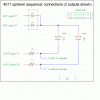4017 & JK F/F up/down connections
Hi, twisted. You've had some time now to work through it, so I thought I'd post my 2 cents. niq_ro has the right idea, though it looks like the LEDs are drawn backwards.
A compact way to solve problems like this is with a small micro, as Panic pointed out. However, designing with micro's has a steeper learning curve than wiring up basic logic circuits, and may be outside the scope of your class.
the materials i can use are
4017 cmos chip
555 cmos timer chip
10 LEDs
JK Flip Flops
(In addition to these parts, you'll need some diodes or OR gates on the 4017 outputs)
Take a look at the schematic in this link for a solution using a 555 and two 4017's (the circuit shown has 9 outputs, not 10. The transistor is used as an inverter. Notice the diodes on outputs Q0 and Q8 aren't logically needed, they're probably included to match brightness levels among the LEDs.).
http://www.geocities.com/lemagicien_2000/elecpage/bounlite/bounlight.html
You can achieve a similar effect using a flip-flop in place of the second 4017. As others have pointed out, the 4017 can only count in one direction.
Simulating a bi-directional count on the 4017 (using all 10 outputs) requires an additional "state" bit. In the partial schematic shown below, a negative-edge triggered JK flip-flop is clocked using the Cout pin from the 4017. The JK should be wired as a toggle flip-flop (both J & K inputs high). The flip-flops' "Q" output is low during counts 0-1-2-3-4, then high for counts 5-6-7-8-9-0-1-2-3-4, then low for counts 5-6-7-8-9-0-1-2-3-4, etc...
The 4017's output pins are wired in pairs as shown, (0,9), (1,8 ), (2,7) etc. The diodes shown in the dotted lines can be replaced by 2-input OR gates, either steering diodes or gates are needed to prevent output contention. Since only one output is on at a time, only two current-limiting resistors are needed
One thing to point out, the LEDs on the end (0 & 9) stay on twice as long as the other LEDs. If you want all of the LEDs to be on for the same amount of time, add an 11th LED (LED10) and connect output pairs (1,9), (2,8 ), (3,7) etc. together. In this case, output 5 drives the same LED in both directions, saving a diode/OR gate. The diodes on outputs "0" and "5" aren't logically needed, but are left in for matching LED light levels. You could also use four 2-input OR gates (74HC32) in place of the diodes.
A few more notes: The CD4017 outputs don't have much drive capability, you may want to use the 74HC4017 instead (Be aware the 'HC parts have a maximum Vcc of 6 Volts). Either way, it would help to use high-efficiency LED's (2mA drive). The JK flip-flop should be a negative-edge triggered version, like the 74HC112. If using a positive-edge version like the CD4027 or 74HC109, Cout from the 4017 needs to be inverted. Remember to tie reset pins to their inactive states, and clock enable pins to their active state.
I haven't tried the circuit out, so it may have some problems. Good luck!
Edit: I just noticed the comments in the attached schematics show doubled output pair connections. The output pairs for driving 10 LEDs are (0,9), (1,8 ), (2,7), (3,6) and (4,5).
The output pairs for driving 11 LEDs are (1,9), (2,8 ), (3,7), and (4,6).










